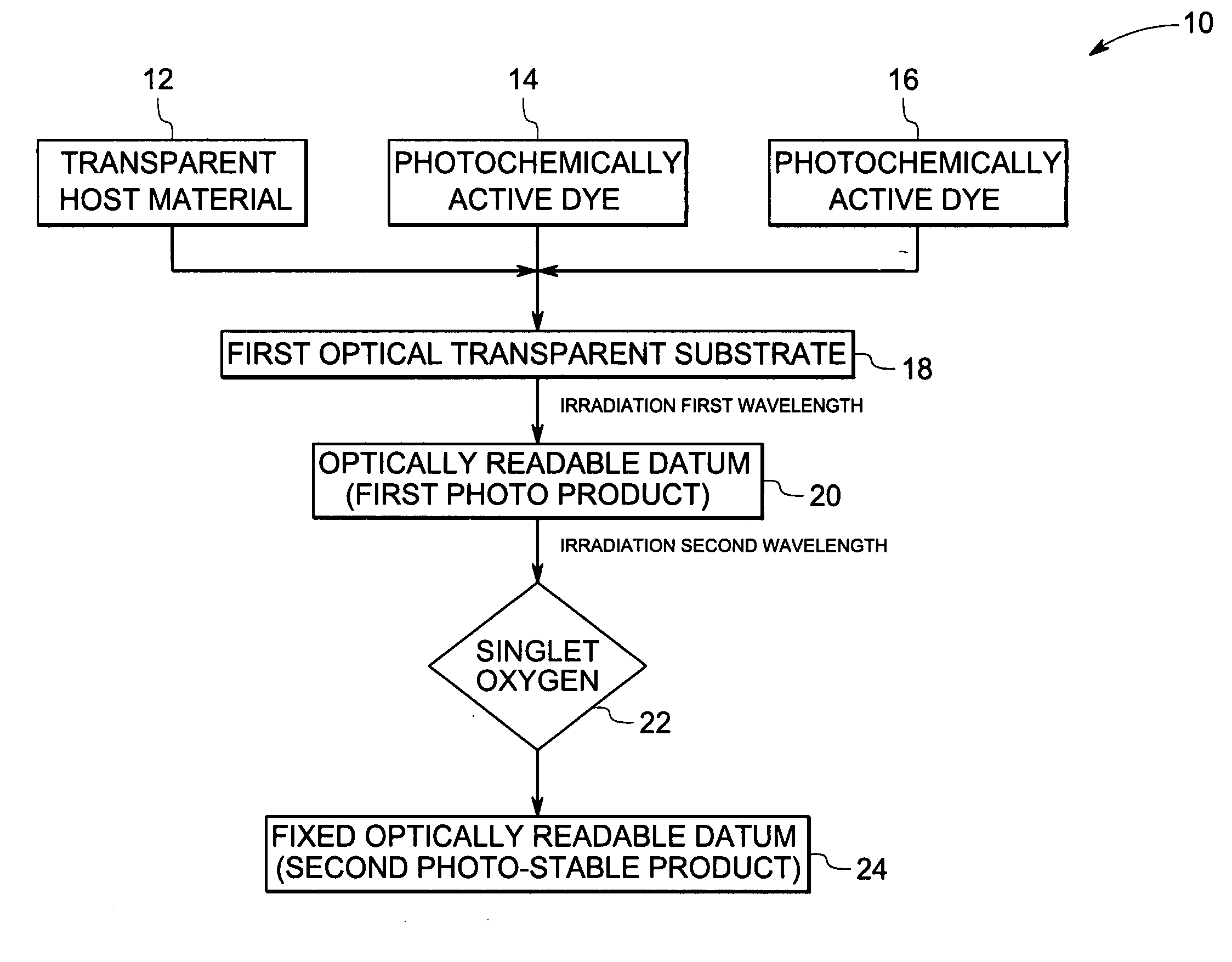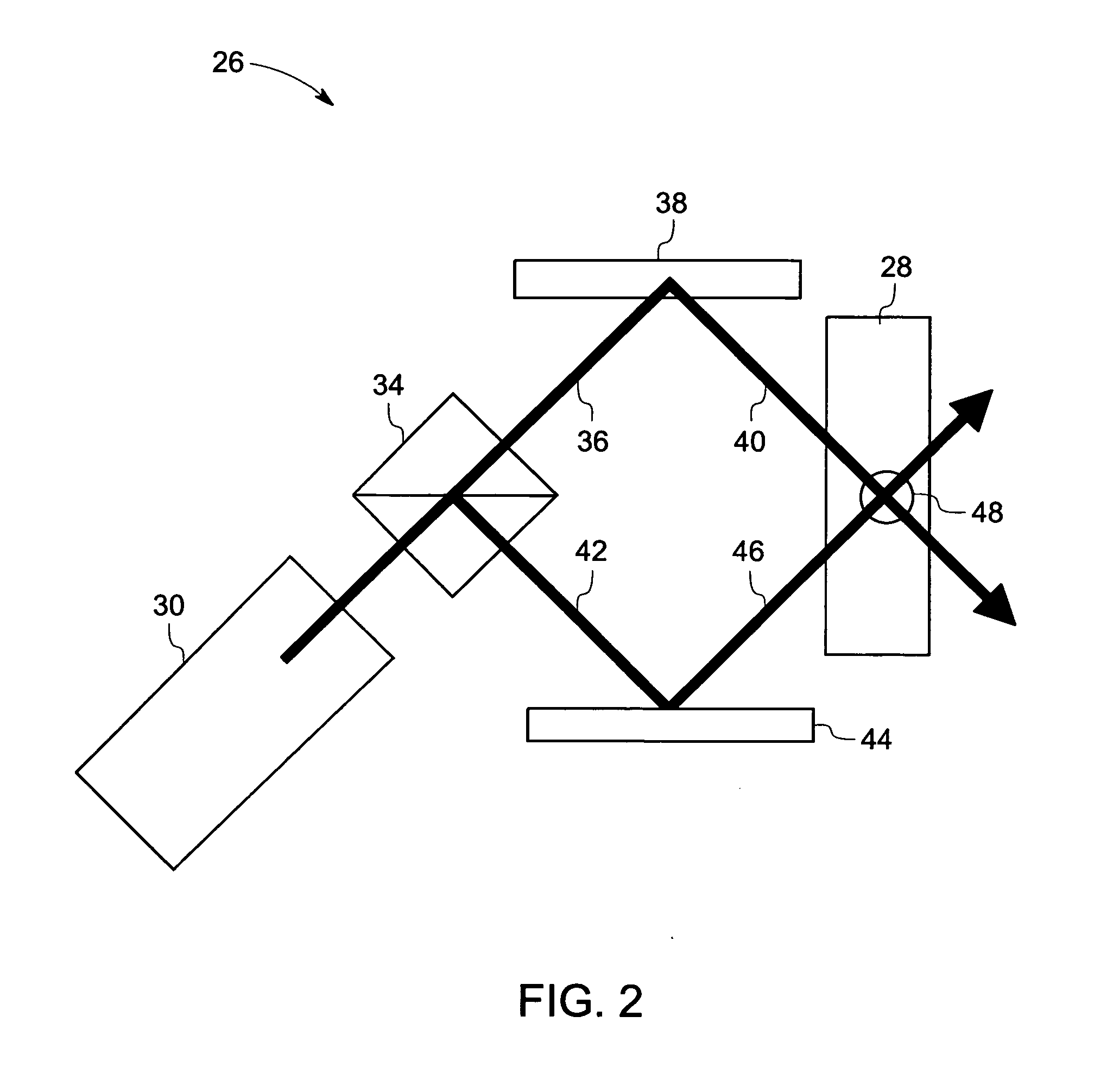Methods for storing holographic data and articles having enhanced data storage lifetime derived therefrom
a technology of holographic data and enhanced storage life, which is applied in the field of methods for storing holographic data, can solve the problems of erasure of written information in such materials, corresponding changes in refractive index, and limited data density of optical media
- Summary
- Abstract
- Description
- Claims
- Application Information
AI Technical Summary
Benefits of technology
Problems solved by technology
Method used
Image
Examples
example 1
[0094] All handling of the compounds described is performed under protection from light or under red-light conditions. 2 g optical quality PMMA (poly(methyl methacrylate)) is dissolved in 10 ml of dichloromethane. 2 ml of this solution is placed in an amber vial and 3 mg of the singlet oxygen sensitizer, ZnNa (zinc 2,11,20,29-tetra-tert-butyl-2,3-naphthalocyanine, CAS Number 39049-43-9, Aldrich Chemical Co.) with structural formula as shown in (X) is added and dissolved. Finally 2 mg of DAEOHo (1,2-bis[5′-(4″-hydroxyphenyl)-2′-methylthien-3′-yl]perfluorocyclopentene) with structural formula (VI) is added and dissolved. The mixture is then solvent cast onto a glass slide to form a film of about 100 micron thickness and the film is dried under a mild vacuum for 24 hours.
[0095] A planewave hologram is written into the dried film by using a 405 nm set-up with a diffraction efficiency of 1%. A plane wave hologram is a recorded interference pattern produced by a signal beam and a refere...
example 2
[0096] An identical film sample is prepared as described above in EXAMPLE 1 and a hologram is written at 405 nm in an identical manner to the one described earlier. The written datum is exposed for 1 hour under an atmosphere of oxygen to an unfocused laser beam of 780 nm light (100 mW over a 5 mm area containing the hologram written into the medium at 405 nm). Next, the decay of the hologram is monitored by using a 405 nm reading laser beam. The beam is focused onto the hologram and the diffraction efficiency is monitored. The diffraction efficiency at time t1 is higher than that observed for the control.
example 3
[0097] A solution (sample A) in acetonitrile solvent of an open form diarylethene (1,2-bis[5′-(4″-hydroxyphenyl)-2′-methylthien-3′-yl]-perfluorocyclopentene, DAEOHo, structural formula (VI)) was prepared. FIG. 5 shows the variation in absorbance (Y-axis 68) with wavelength (X-axis 70), before and after exposure to 405 nm bleaching radiation. Absorption profile 72 was measured before exposure to bleaching radiation. Sample A was then subjected to a bleaching radiation at a wavelength of 405 nm for 9 minutes. Absorbance versus wavelength profile 74 was again measured. Profile 74 displays a prominent peak at about 600 nm, which was not observed in the absorption profile 72 before the bleaching exposure, indicating the presence of a photo-product as a result of the bleaching exposure. Although the Applicants do not wish to be bound by any particular theory, it is believed that upon exposure to bleaching radiation at 405 nm, the open form diarylethene (DAEOHo) undergoes a cyclization rea...
PUM
| Property | Measurement | Unit |
|---|---|---|
| wavelength | aaaaa | aaaaa |
| thick | aaaaa | aaaaa |
| wavelength | aaaaa | aaaaa |
Abstract
Description
Claims
Application Information
 Login to View More
Login to View More - R&D
- Intellectual Property
- Life Sciences
- Materials
- Tech Scout
- Unparalleled Data Quality
- Higher Quality Content
- 60% Fewer Hallucinations
Browse by: Latest US Patents, China's latest patents, Technical Efficacy Thesaurus, Application Domain, Technology Topic, Popular Technical Reports.
© 2025 PatSnap. All rights reserved.Legal|Privacy policy|Modern Slavery Act Transparency Statement|Sitemap|About US| Contact US: help@patsnap.com



